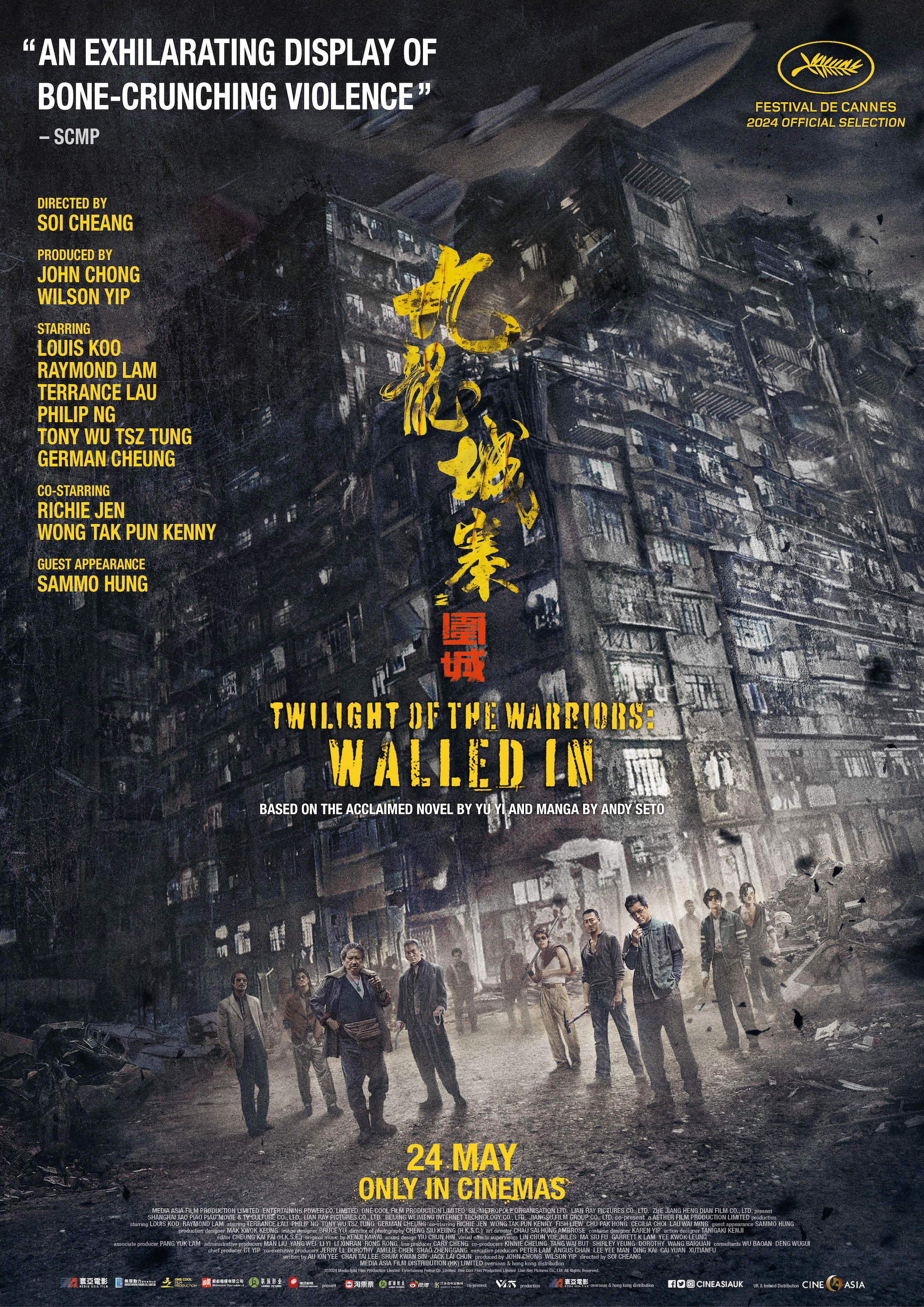
- Starring
- Raymond Lam, Louis Koo, Terrance Lau, Tony Wu, German Cheung, Philip Ng, Sammo Hung
- Writers
- Au Kin Yee, Chan Tai Lee, Shum Kwan Sin, Jack Lai Chun
- Director
- Soi Cheang
- Rating
- n/a
- Runtime
- 126 minutes
- Release Date
- October 2024 (TBA)
Overall Score
Rating Summary
The following is a review from the 77th Cannes Film Festival. Twilight of the Warriors: Walled In is in theatres in the UK and Ireland and is set for release in North America this October.
Twilight of the Warriors: Walled In is the long awaited Hong Kong action film with a production as chaotic as the city in which this story takes place in. Based on the novel (and manga of the same name) “City of Darkness”, this adaptation has been in development for over 20 years, at one point nearly being co-directed by legendary filmmakers John Woo AND Johnnie To, before finally being brought to life by rising star director Soi Cheang (Limbo, Mad Fate, SPL 2, Dog Bite Dog) and an all star cast, making the film one of the most expensive and hotly anticipated Hong Kong films ever made. Set in 1980s Hong Kong, Twilight of the Warriors follows Chan Lok-kwan (Raymond Lam), a refugee on the run from crime boss Mr. Big (Sammo Hung) and his psychotic Joker-like right hand man, King (Phillip Ng) who finds a safe haven in the walled city of Kowloon. Chan finds himself taken under the wing of triad boss Cylcone (Louis Koo) and becomes part of the community, gaining new friends and learning to open up again after a lifetime on the run fending for himself. But when old secrets come out, Chan’s new life is thrown into chaos as generational blood feuds and invading gangs threaten to usurp life for him and everyone else in the walled city.
While the film itself tells a fictionalized martial arts wuxia story, the city which it takes place was all too real and beautifully realized on screen. To help paint the picture, in its prime, Kowloon was the densest place on Earth with over 35,000 residents packed into 6 acres of land, a city bereft of any governmental regulation making it a hotbed of criminal activity while also fostering a tight knit community. A crumbling concrete mish mash of shanty like abodes, cramped restaurants, and electrical wires and piping protruding out of every orifice of the city, the recreation of Kowloon is nothing if not a production and set design marvel. Cheang’s horror roots shine through here in crafting an intoxicating and grimy atmosphere within the city, making it feel like a truly lived in environment which helps to punctuates the moments of community and kinship found within its walls. Kowloon is as much a character of this film as everyone else and Twilight of the Warriors serves as both an homage to the walled city as it does to classic Hong Kong action films, a throwback that seeks to revitalize an old school energy with new blood.
At its core, Twilight of the Warriors: Walled In is a film about generational divides which manifests itself in various different ways. The most obvious is the film’s casting, which sees a mix of up and comer talent with long time legends in the industry such as, Louis Koo, Aaron Kwok and most famously Sammo Hung (in his first action role in nearly a decade). The casting of such icons inherently gives an added weight to their characters, the history we as an audience associate with their on screen personas transfers over to the drama here. The film opens on a flashback sequence (of which the film returns to throughout) showcasing the gang war that led to Cyclone controlling Kowloon and the decisive events that define the present day feuds. The scars of the past are the driving force of the narrative and serve as a constant reminder in the set design itself, with the slashes, imprints and cracks adorning the walls from fights long ago.
While the film ostensibly follows Chan and his journey, the history bubbling under the surface fleshes out the melodrama and worldbuilding. A recently announced prequel (and sequel) will fully explore the backstory and gang war but to Walled In‘s credit, the hints presented here don’t feel like mere franchise set up. If all audiences got was one film, one wouldn’t necessarily feel like anything was missing. As this generational struggle unfolds, Cheang foregrounds the fate of the city with news footage about the impending hand over of Hong Kong from the UK back to China. The city of Kowloon’s destruction once this new era of Hong Kong begins is all but assured. Our protagonist’s struggle between two worlds, that of his new home in Kowloon and his former life as a refugee mirroring the transformation of Hong Kong around him. For what is an otherwise fairly straightforward narrative about revenge and finding oneself in a newfound family, Walled In adds just enough tertiary details to make the story and characters more engaging.
Where Twilight of the Warriors shines, however, is within its action scenes, of which there are many! The action choreography by Kenji Tanigaki (best known for doing action design and stunts for Donnie Yen’s team) is a unique blend combining classic kung fu, MMA (mixed martial arts) and wuxia style superpowers, like a cross between The Raid and Crouching Tiger Hidden Dragon. In keeping with the film’s ideas of generational divides, the older triad bosses played by HK legends fight using classic kung fu techniques while our young cast utilize grappling and modern MMA techniques. This diversity in approach to the choreography keeps the action fresh and helps informs the overall themes of the film, the best action always reveals things about the characters that dialogue scenes cannot. The cramped environments and verticality of Kowloon open themselves up to staging a number of impressive set pieces incorporating its unique geography and environmental detail. With action moving up across rooftops and smashing through the piping and wiring that adorn the city, no fight scene is like the last and as the film’s manga comic book roots begin to emerge in the third act, the action explodes into full blown wuxia mayhem with a “twist” as out of left field as it is entertaining.
In the end, Twilight of the Warriors: Walled In more than lives up to the hype with an engaging narrative, likeable characters, intriguing world building, and awe inspiring action set pieces bringing back that classic action movie energy that Hong Kong cinema defined back in the day.
still courtesy of Trinity Cine Asia
If you liked this, please read our other reviews here and don’t forget to follow us on Twitter or Instagram or like us on Facebook.


